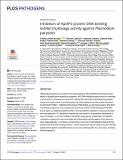| dc.contributor.author | Russell, Timothy James | |
| dc.contributor.author | De Silva, Erandi K | |
| dc.contributor.author | Crowley, Valerie M | |
| dc.contributor.author | Shaw-Saliba, Kathryn | |
| dc.contributor.author | Dube, Namita | |
| dc.contributor.author | Josling, Gabrielle | |
| dc.contributor.author | Pasaje, Charisse Flerida A | |
| dc.contributor.author | Kouskoumvekaki, Irene | |
| dc.contributor.author | Panagiotou, Gianni | |
| dc.contributor.author | Niles, Jacquin C | |
| dc.contributor.author | Jacobs-Lorena, Marcelo | |
| dc.contributor.author | Denise Okafor, C | |
| dc.contributor.author | Gamo, Francisco-Javier | |
| dc.contributor.author | Llinás, Manuel | |
| dc.date.accessioned | 2023-02-06T15:05:54Z | |
| dc.date.available | 2023-02-06T15:05:54Z | |
| dc.date.issued | 2022 | |
| dc.identifier.uri | https://hdl.handle.net/1721.1/147888 | |
| dc.description.abstract | <jats:p><jats:italic>Plasmodium</jats:italic> parasites are reliant on the Apicomplexan AP2 (ApiAP2) transcription factor family to regulate gene expression programs. AP2 DNA binding domains have no homologs in the human or mosquito host genomes, making them potential antimalarial drug targets. Using an <jats:italic>in-silico</jats:italic> screen to dock thousands of small molecules into the crystal structure of the AP2-EXP (Pf3D7_1466400) AP2 domain (PDB:3IGM), we identified putative AP2-EXP interacting compounds. Four compounds were found to block DNA binding by AP2-EXP and at least one additional ApiAP2 protein. Our top ApiAP2 competitor compound perturbs the transcriptome of <jats:italic>P</jats:italic>. <jats:italic>falciparum</jats:italic> trophozoites and results in a decrease in abundance of log<jats:sub>2</jats:sub> fold change > 2 for 50% (46/93) of AP2-EXP target genes. Additionally, two ApiAP2 competitor compounds have multi-stage anti-<jats:italic>Plasmodium</jats:italic> activity against blood and mosquito stage parasites. In summary, we describe a novel set of antimalarial compounds that interact with AP2 DNA binding domains. These compounds may be used for future chemical genetic interrogation of ApiAP2 proteins or serve as starting points for a new class of antimalarial therapeutics.</jats:p> | en_US |
| dc.language.iso | en | |
| dc.publisher | Public Library of Science (PLoS) | en_US |
| dc.relation.isversionof | 10.1371/JOURNAL.PPAT.1010887 | en_US |
| dc.rights | Creative Commons Attribution 4.0 International license | en_US |
| dc.rights.uri | https://creativecommons.org/licenses/by/4.0/ | en_US |
| dc.source | PLoS | en_US |
| dc.title | Inhibitors of ApiAP2 protein DNA binding exhibit multistage activity against Plasmodium parasites | en_US |
| dc.type | Article | en_US |
| dc.identifier.citation | Russell, Timothy James, De Silva, Erandi K, Crowley, Valerie M, Shaw-Saliba, Kathryn, Dube, Namita et al. 2022. "Inhibitors of ApiAP2 protein DNA binding exhibit multistage activity against Plasmodium parasites." PLoS Pathogens, 18 (10). | |
| dc.contributor.department | Massachusetts Institute of Technology. Department of Biological Engineering | en_US |
| dc.relation.journal | PLoS Pathogens | en_US |
| dc.eprint.version | Final published version | en_US |
| dc.type.uri | http://purl.org/eprint/type/JournalArticle | en_US |
| eprint.status | http://purl.org/eprint/status/PeerReviewed | en_US |
| dc.date.updated | 2023-02-06T14:51:11Z | |
| dspace.orderedauthors | Russell, TJ; De Silva, EK; Crowley, VM; Shaw-Saliba, K; Dube, N; Josling, G; Pasaje, CFA; Kouskoumvekaki, I; Panagiotou, G; Niles, JC; Jacobs-Lorena, M; Denise Okafor, C; Gamo, F-J; Llinás, M | en_US |
| dspace.date.submission | 2023-02-06T14:51:14Z | |
| mit.journal.volume | 18 | en_US |
| mit.journal.issue | 10 | en_US |
| mit.license | PUBLISHER_CC | |
| mit.metadata.status | Authority Work and Publication Information Needed | en_US |
